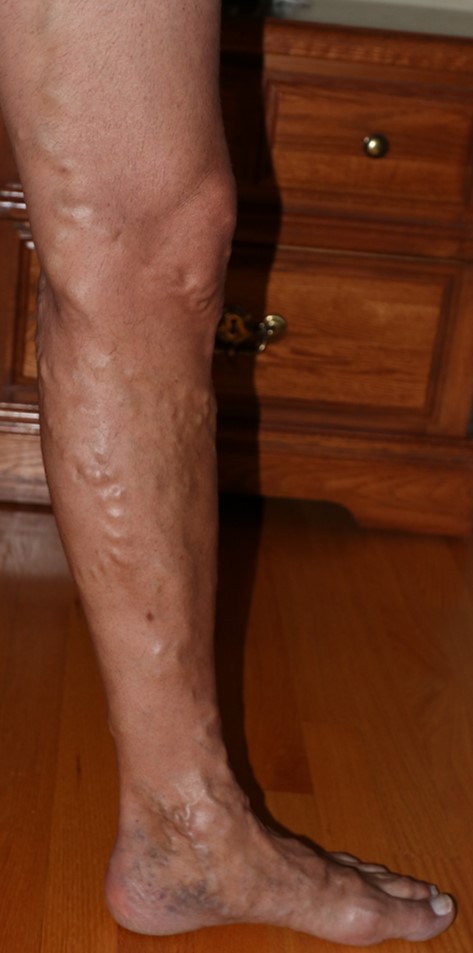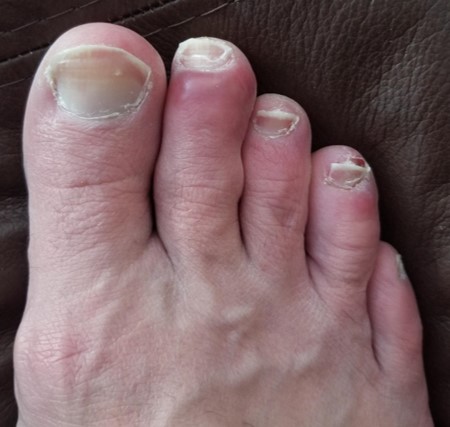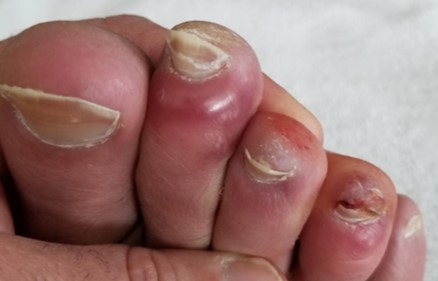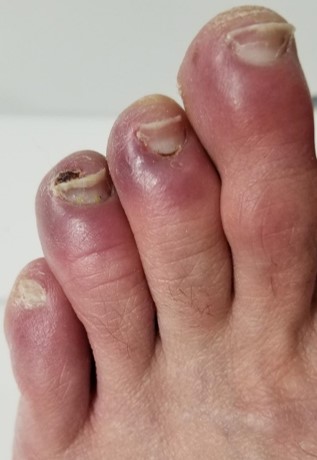- Home
- Chilblains
Chilblains Problem on Toes and Fingers
Visit this
PICTURES OF RASHES PAGE
Chilblains problem on toes and other extremities of the body is a skin care condition that affects many individuals. Some people confuse this problem with the affects of frostbite, but it is different, since exposure to extreme cold temperatures is not necessary to trigger chilblains.
What is Chilblains Problem on Toes?
Chilblains is characterized by symptoms such red and swollen skin. The skin may be itchy and flaky. Also, blisters can develop on the skin, sometimes filled with clear fluid and sometimes with blood. Although it can occur on the fingers and nose, most commonly, it is found on the toes.
Chilblains problem on toes and other areas of the body can be quite painful. This is especially a problem for toes because it makes wearing socks and shoes and even just walking painful.
Chilblains Causes
The cause of chilblains is not fully understood. It seems to be triggered by exposure to cold or cooler temperatures which triggers poor blood circulation. This reduced blood circulation may be responsible for the chilblains problem on toes and fingers.
Case Study on Chilblains
Below is a personal case study of the chilblains problem on toes. The personal account is from a male in his fifties.
History
In the past, even up to my early fifties, I never had any problem with chilblains. In fact, it is something I never heard about or even knew about. However, it started to occur after several events.
COVID Vaccinations
The first event was getting vaccinated for COVID. Several months after receiving 2 doses (the first being Pfizer and the second Moderna), I developed this issue on my toes on both feet. Nothing else in my health had changed, no new medications, no other vaccines.
COVID
The second event was that I caught COVID. On the Internet, you will find stories of people getting COVID toes, which by the pictures presented, looks like the chilblains problems on toes. However, checking dates, I realized that, I had developed chilblains before catching COVID and so that could not be it.
Varicose Vein Treatments
The third event was treatment for my varicose veins problem. I have had vein issues on both legs for many years and finally decided to get treatment. The pictures below are of my left leg from the side and back, showing the extent of the problem. The right leg was not as bad, but treatments were still necessary to restore better functioning circulation in my legs.


The treatments were a combination of Endovenous Laser Treatment (EVLT), where a laser probe is guided into the non-functioning vein to seal the vein and then it dies, and Sclerotherapy, where a chemical agent is injected into the vein in order to destroy it.
The EVLT procedure is used on larger veins and the main veins in the upper thigh and back of the knee. The Sclerotherapy is effective on smaller veins below the knee. EVLT was performed in my upper thigh and behind the knee on my left leg and only upper thigh on my right. Numerous Schlerotherapy injections were performed on both legs but more on the left.
In summary, the left leg experienced more extensive treatments than the right leg. Chilblains problem on toes started to become evident a few months after starting vein treatments.
COVID Vaccinations or Vein Treatments
So what caused my chilblains problem? it is difficult to say with certainty. There were reports of the Moderna vaccine causing a thrombosis problem in some people and so perhaps it played a role in the circulation in my legs. On the other hand, all the vein treatments changed the way blood circulates through my legs and perhaps this was the trigger. Regardless of why it happened, it has happened.
Chilblains on Toes
My chilblains toe problem has all the symptoms mentioned previously: red toes, swollen toes, blood filled or clear fluid filled blisters, flaky skin, and very painful and sensitive toes. The symptoms appear in the winter. In the summer, the chilblains goes away. The warmer weather must promote better circulation and therefore no chilblains. Although the toes on both feet have experienced this problem, the toes on the left foot are by far the worst. This leads me to believe that the cause is more likely the extensive varicose vein treatments on my left leg, rather than the Moderna COVID vaccine.
I am required to wear compression stockings to help with my vein issues. However, I stopped wearing them because they aggravate the chilblains on my toes. I have tried often to wear the socks again, but each time the chilblains gets worse.
Chilblains Pictures
Below are some of my pictures of the chilblains problem on toes.



Chilblains Treatments
The first treatment is simply to wait it out. Once the warm weather hits the problem disappears. However, dealing with painful toes for several months is not ideal and therefore, some sort of chilblains treatment is necessary.
One thing to try is to keep the toes warm at all times. Wearing slippers or thermal type socks helps. Do not walk around barefoot in winter, especially on cold floors (ceramic tile, etc.).
There is also a prescription cream that can be applied to the toes. See your doctor to obtain this cream. It is messy and has to be applied two times per day, but I found it works fairly well after a few days of use.
Comments
Chilblains on Toes after Knee Surgery
Jake, United States
I have had a chilblains problem on my toes in the past. Recently, during winter time, I had knee surgery. For the first three days, I had to keep off my feet and keep my leg elevated as much as possible to limit knee swelling. I already have poor circulation and with the colder house temperature in winter, leg tensor bandage on the knee, leg elevation, and lack of movement, the chilblains problem on my toes flared up significantly. Currently, the toes are very red and painful. I am hoping that since I no longer need to elevate the leg, the chilblains will begin to subside.
If you have a comment or would like to share your chilblains experience, please fill out the form below.
